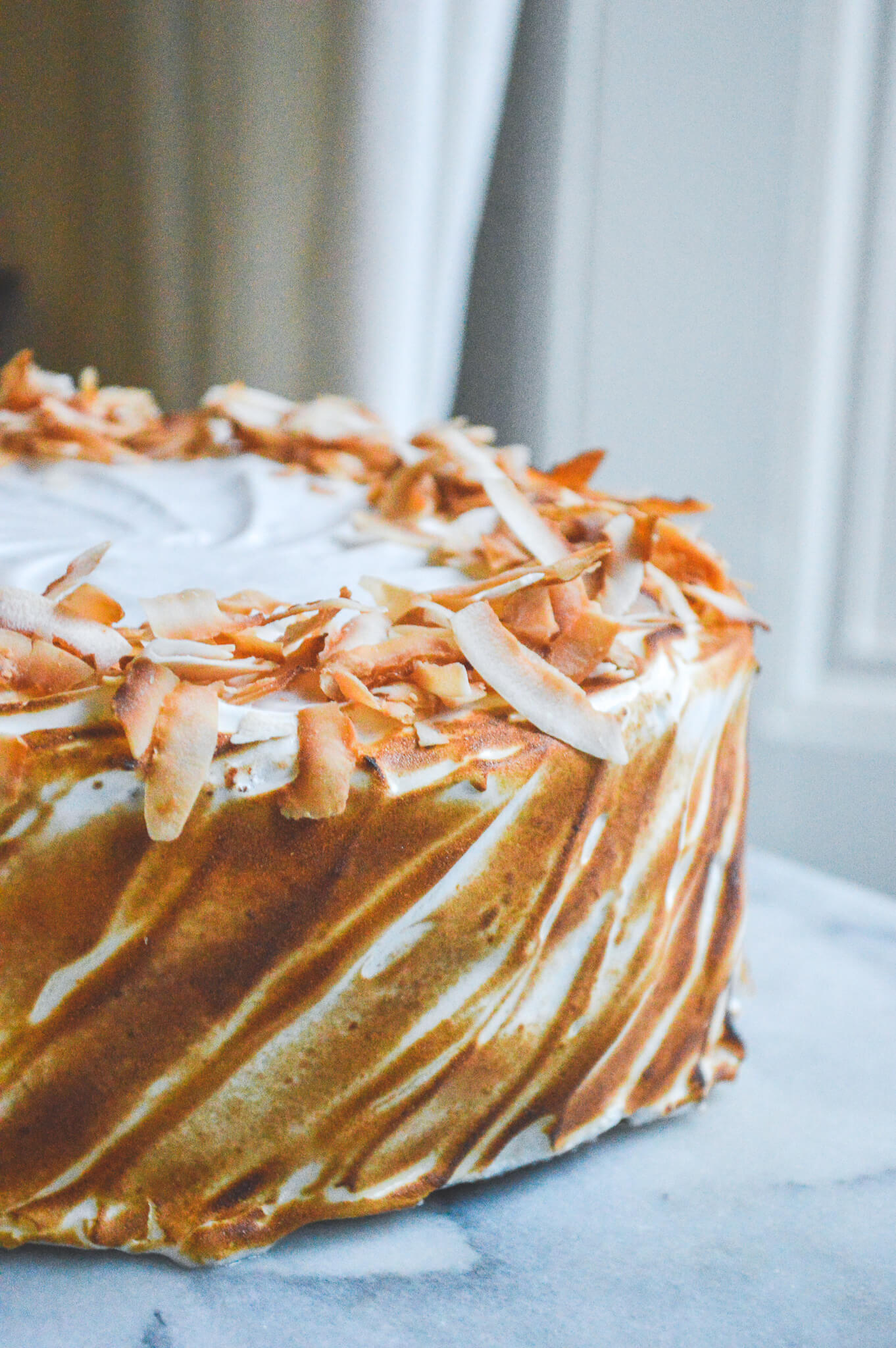Developed from Paul Holywood, Claire Saffitz and Great Italian Chefs
Sometimes, in life, you meet someone who warrants the effort of scorched Italian meringue. If you are lucky enough to find this person; you should be equipped with this recipe.
I’ve broken this into 3 stages. The caramel, the cake and the meringue. Make them in that order.
Toasted Coconut Caramel
- 400g castor sugar
- 460g double cream
- 218g coconut oil
- 1/2 tsp salt
- 200g toasted desiccated coconut
- Sprinkle enough sugar over a pan to cover the base and heat gently. As this sugar beings to melt, sprinkle more sugar. Repeat this until all sugar is dissolved, swirling the pan if sugar is melting unevenly.
- Gently heat the sugar until it reaches a deep brown colour.
- While still on the heat, add the cream to the pan. It will begin to bubble violently.
- Continue to stir with a whisk, there may be some caramel that hardens, but this will melt.
- Stir in the salt and gradually add chunks of the coconut oil.
- When the caramel cream mixture is of the same consistency, add the toasted coconut and remove from heat.
- Spoon into a bowl and cool to room temperature. Once at room temperature, the caramel will be a thick, spoonable consistency.
Genoise Sponge
- 50g butter, melted, plus extra for greasing
- 250g plain flour, plus extra for dusting
- 250g caster sugar plus 1 tbsp
- 8 medium eggs
- Heat oven to 190C/170C fan/gas 5. Brush 2 x 20cm cake tins with melted butter, line the bases with baking paper, then dust well with flour, tapping out any excess. Set aside.
- Put the sugar and eggs in a large heatproof bowl, then set it over a pan of barely simmering water. Whisk with an electric hand whisk until the mixture is trebled in volume and has the consistency of a thick pancake batter. (You should be able to take the whisk and make a figure of 8 that will sit on top of the batter before sinking in.)
- Remove from the heat and spoon a cup of the batter into a separate bowl. Pour the melted butter into the batter and fold to incorporate. This will make it infinitely easier to combine with the rest of the batter.
- Then slowly pour in the butter mixture folding it in as you pour until it is completely mixed in.
- Gently fold the flour and a pinch of salt into the egg mixture, then pour into your prepared cake tins. Cook for 25 mins until the cake is golden and risen – a skewer pushed into the cake should come out clean. Allow the cakes to cool for a few mins in the tin, then remove and cool completely on a wire rack.
Italian meringue
- 200g of caster sugar
- 50g of water
- 100g of egg white
- Put the sugar and water into a small saucepan over medium heat with a thermometer resting in the liquid
- Start to slowly whisk the egg whites either in a stand mixer or with a hand-held electric whisk until just starting to foam
- Heat the sugar until it reaches 121°C then slowly pour into the egg whites whilst still whisking
- Turn the whisk up to full speed and whisk until cooled to room temperature – the meringue is now ready to use
Putting it all together
- Cut your cake layers into 4 equal layers.
- Fill a pastry bag with one 1/3 of your Italian meringue and pipe a border around the base layer. Spoon coconut caramel into the centre of the cake layer and with an offset spatula, or the back of a spoon, push the caramel to the meringue border.
- Repeat this step with each of the layers until you add the top layer.
- Dollop your remaining meringue into the top of the cake. Using your offset spatula, push the meringue out of the centre and down the sides. Using a bench scraper, level the top and sides of the cake, before adding decorative swirls, twirls, ripples and however else you want to adorn your cake.
- Go wild with a blow torch.
- For extra credit, garnish with toasted coconut shavings.


